The #1 Local SEO Secret Your Competitors Are Ignoring (And How to Steal It)
Unlock the strategy to dominate local search and leave your rivals in the dust.
Authoritative Resources to Enhance Your Learning
We believe in providing well-researched, actionable advice. To deepen your understanding, we’ve curated a list of official and expert resources on Local SEO and digital marketing. We reference these throughout the article.
- Google Business Profile Help Center (Official Guidelines)
- Google’s SEO Starter Guide (Core SEO Principles)
- Moz’s Guide to Local SEO (Expert Learning Hub)
- BrightLocal’s Local SEO Resources (Local Search Specialists)
- HubSpot’s Local Marketing Blog (Business Strategy Focus)
Every day, potential customers in your neighborhood are searching online for the exact products or services you offer. They type “plumber near me,” “best coffee shop in [Your City],” or “family dentist [Your Town]” into Google.
The question is, do they find you, or do they find your competitor? For many small and medium-sized businesses, the answer is frustratingly the latter. You have a great website, you’ve set up your Google Business Profile, but you’re still invisible on the map.
The reason? You’re playing checkers while your top-ranking competitors are playing chess. They are leveraging a powerful Local SEO secret that most businesses overlook entirely.
This guide will reveal that secret and give you a step-by-step blueprint to ethically “steal” their competitive advantage and claim your spot at the top of Google’s local search results. For a foundational understanding of the principles at play, the experts at Moz offer an excellent guide to Local SEO.
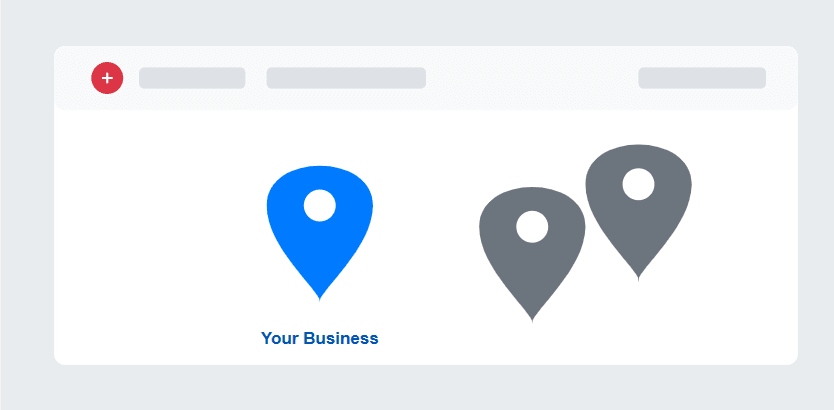
The Fundamental Flaw in Most Local SEO Strategies
Before we unveil the secret, let’s talk about why most Local SEO efforts fail to deliver significant results. The common advice is to “optimize your Google Business Profile” and “get some reviews.” While not bad advice, it’s incomplete.
It’s like telling a aspiring chef to “just use good ingredients.” It misses the crucial element of strategy. As the team at HubSpot often explains, a strategic approach to local marketing is what separates thriving businesses from those that are merely surviving.
Most business owners perform a one-time setup of their Google Business Profile (GBP) and then treat it like a digital business card—static and forgotten. They might add a few photos when they launch and respond to a review here and there.
But their competitors who are ranking on page one? They are treating their GBP as a dynamic, living marketing asset. They are constantly feeding it new signals, engaging with their audience, and, most importantly, they are making data-driven decisions based on what’s already working.
This is the core of a successful Local SEO strategy. The secret isn’t a magic button; it’s a systematic process of analysis and implementation that your competition is too lazy or too uninformed to do.
Revealing the #1 Local SEO Secret: The Competitor GBP Gap Analysis
The single most powerful and underutilized strategy in Local SEO is a systematic, data-driven Competitor Google Business Profile (GBP) Gap Analysis. That’s a mouthful, but the concept is simple.
Instead of guessing what Google wants to see, you let your top-ranking competitors tell you. You reverse-engineer their success.
This “secret” involves going far beyond a simple glance at their profile. It means dissecting every element of their GBP—their categories, their photos, their posts, their reviews, their Q&A section—and comparing it directly, point-by-point, with your own.
The “gaps” you discover are your roadmap to #1. These gaps represent missed opportunities, untapped keywords, and weaknesses in your own Local SEO efforts. By identifying and systematically closing these gaps, you are effectively “stealing” their strategy and using it to propel your own business to the top of local search. This is the most effective form of competitive intelligence for any local business.
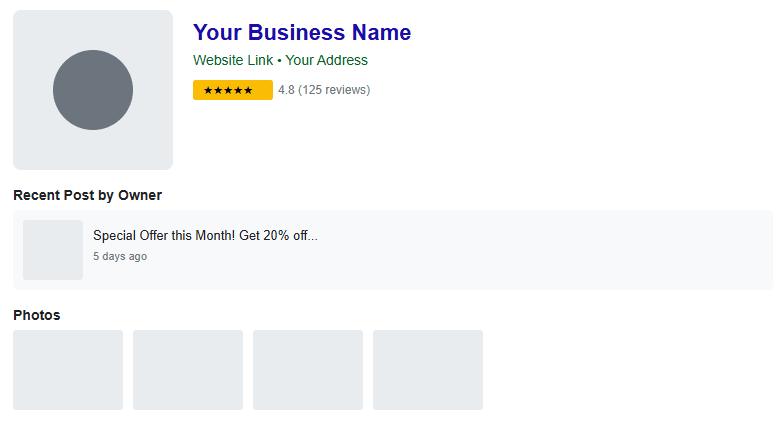
Ready to Steal Their Strategy?
We’ve created the perfect tool to get you started. Download our free Competitor GBP Analysis Spreadsheet Template to systematically track your findings and build your winning Local SEO plan.
The “How to Steal It” Blueprint: A 4-Phase Plan
Knowing the secret is one thing; executing it is another. Here is your actionable, four-phase blueprint to perform a GBP Gap Analysis and transform your local online visibility.
Phase 1: Identify Your True Local SEO Competitors
Your real-world competitors aren’t always your true Local SEO competitors. You need to find out who is currently occupying the valuable real estate in Google’s “Local Pack” (the map and three listings that appear for local searches).
- Open an Incognito Window: Go to Google and search for your most important service keyword followed by your city or neighborhood (e.g., “emergency plumber brooklyn”). Using an incognito window helps prevent personalization from skewing the results.
- Map the Top 3-5 Listings: Who consistently appears in the Local Pack for this and other related keywords? These are your primary targets. Write down their business names.
- Repeat for Different Keywords: Perform this search for 3-5 of your core services. You might find different competitors ranking for different terms. Create a master list of the top 3-5 businesses that appear most frequently. This is your hit list for analysis. This initial research is a cornerstone of any serious Local SEO campaign.
Phase 2: The Deep Dive – Auditing Their GBP Like a Detective
Now, open a spreadsheet (you can use our free template!) and create columns for each competitor and one for your own business. You will now go through each competitor’s profile with a fine-tooth comb and fill out the spreadsheet.
For the official word on what’s possible and allowed, always refer to the Google Business Profile Help Center. Here is your checklist:
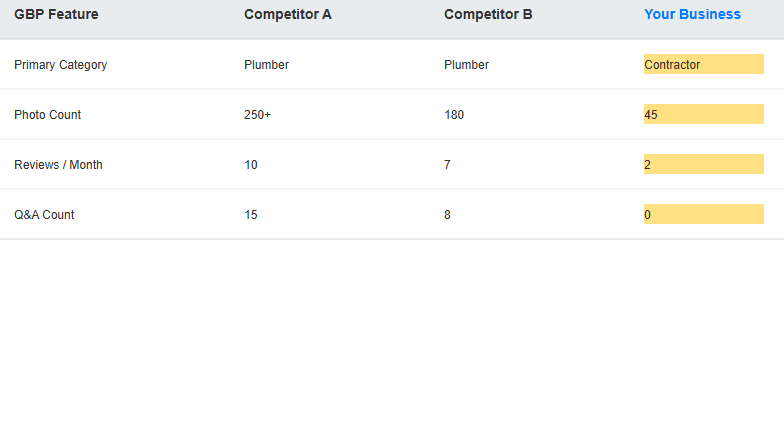
1. GBP Categories
This is one of the most critical ranking factors. Note their primary category and all secondary categories. Are they using a category you aren’t? Are they using a more specific one?
For example, instead of just “Restaurant,” are they using “Italian Restaurant” or “Pizza Restaurant”? This specificity is a key Local SEO signal.
2. Business Name & Description
Are they keyword-stuffing their name (e.g., “Best NYC Plumbing & Heating Service”)? While this is against Google’s guidelines and risky, it’s important to note if they’re doing it and getting away with it.
More importantly, analyze their business description. What keywords do they use? How do they frame their unique value proposition? Your description needs to be compelling and keyword-rich.
3. Photos & Videos
This is a massive area for gaining an edge. Don’t just look; quantify it.
- Quantity: How many photos do they have? (Aim for 100+).
- Types: Do they have a logo, a cover photo, exterior shots, interior shots, photos of their team, photos of their work in progress, photos of their products? Each type sends a different signal to Google.
- Geotagging: Savvy businesses geotag their photos with their business location. You can’t see this directly, but you should assume the best are doing it. This is a powerful Local SEO tactic you must adopt.
- Video: Do they have a virtual tour or short videos? Video is a huge engagement signal.
4. Google Posts
Are they using the Posts feature? This is a goldmine. Look at the frequency (are they posting weekly?), the type (Update, Offer, Event), and the content.
Are they using keywords in their posts? Are they including a clear call-to-action and a link? Consistent posting is a strong signal of an active, relevant business, which is a major plus for Local SEO.
5. Products/Services
Does GBP allow them to list specific products or services? If so, are they using this feature? How detailed are their descriptions? Do they include prices? This is another area to provide rich, structured data that Google loves.
6. Reviews
Reviews are the lifeblood of Local SEO.
- Quantity & Velocity: How many reviews do they have? How many new ones are they getting per month? A steady stream of new reviews is a powerful signal.
- Rating: What is their star rating?
- Keywords in Reviews: Read their reviews. Do customers naturally mention specific services (e.g., “great emergency repair,” “fantastic wedding cake”)? These are keyword-rich testimonials that boost rankings.
- Owner Responses: Are they responding to every review, both positive and negative? This shows they are engaged and care about customer service.
7. Q&A Section
This is the most overlooked part of GBP. Look at the questions they’ve received. More importantly, look at the answers.
Often, the business owner will seed this section with their own common questions and provide keyword-rich answers. This is a chance to control the narrative. You can “steal” their best ideas for questions to add to your own profile.
Pro Tip: The Power of Citations
While auditing their GBP, do a quick search for their business name. Look at the top directories (Yelp, Yellow Pages, etc.) that come up. Consistency of their Name, Address, and Phone Number (NAP) across the web is a foundational Local SEO factor.
Note where they have listings that you don’t. These are called citations, and they build trust with Google. For a deep dive into this topic, BrightLocal’s resources are unparalleled.
Phase 3: Find the Gaps
With your spreadsheet filled out, the patterns will emerge. Now, create a “Gap Analysis” column.
- Category Gap: “Competitor A is using ‘HVAC Repair’ as a secondary category, and I’m not. I need to add that.”
- Photo Gap: “Competitor B has over 200 photos, including 50 of completed projects. I only have 20. I need to add more project photos.”
- Post Gap: “Competitor C posts a weekly offer. I haven’t posted in 3 months. I need to create a content calendar for GBP Posts.”
- Review Gap: “My top competitor gets 5 new reviews a month. I only get 1. I need a more aggressive system for requesting reviews.”
- Q&A Gap: “They have answered 10 common questions. I have none. I need to add 5-10 of my own Q&As immediately.”
Phase 4: Execution – Ethically “Stealing” and Implementing
This is where you take action. Go through your “Gap Analysis” column and start implementing the changes on your own Google Business Profile.
- Add the missing categories.
- Rewrite your description to be more compelling and include the keywords your successful competitors use.
- Launch a photo initiative. Take pictures of everything. Get your team involved. Geotag them before you upload.
- Create a posting schedule. Use a simple calendar to plan one or two posts per week. Announce a special, highlight a team member, share a customer success story.
- Systematize your review generation. Create a simple process (email, text message, printed handout) to ask every happy customer for a review.
- Populate your Q&A section. Think of the top 10 questions customers ask you and write detailed, keyword-rich answers.
Beyond the Secret: Amplifying Your Local SEO Results
The GBP Gap Analysis is the engine, but you need fuel to keep it running. Here are three foundational pillars that support your efforts and ensure long-term dominance in local search.
1. On-Page Local SEO Signals
Your website needs to scream “local” to Google. For a comprehensive overview of all on-page factors, Google’s own SEO Starter Guide is the definitive resource.
- Dedicated Location Pages: If you have multiple locations, each one needs its own dedicated page with its unique address, phone number, embedded map, and unique content.
- Local Schema Markup: This is a piece of code you add to your website that helps search engines understand your business information (like your address, hours, and reviews) in a structured way. It’s a direct signal to Google. Implementing LocalBusiness schema is a technical but highly effective Local SEO tactic.
- Localized Content: Write blog posts about local events, news, or topics relevant to your community. This demonstrates your local expertise and connection.
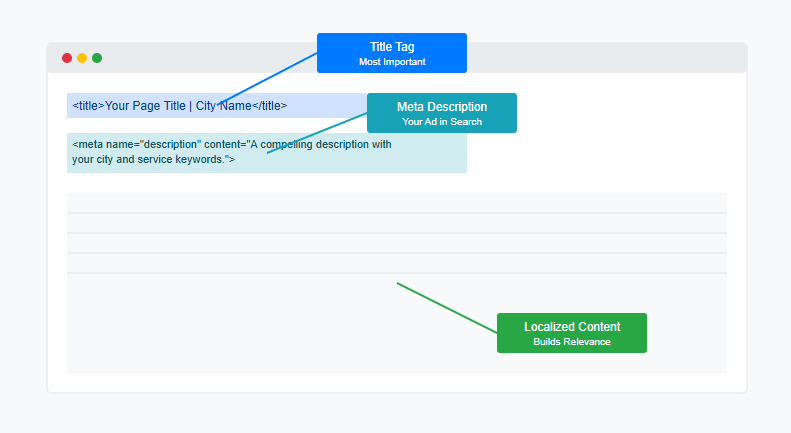
2. High-Quality Local Citations
As mentioned earlier, citations are mentions of your business’s NAP (Name, Address, Phone Number) on other websites. The key is consistency.
An inconsistent NAP (e.g., “St.” on one site and “Street” on another) confuses Google and can hurt your rankings. Use a service like Moz Local or BrightLocal to find and fix inconsistent citations across the web. This is a foundational cleanup task for any serious Local SEO campaign.
3. The Power of Consistent NAP
This is so important it needs its own section. Your NAP must be 100% identical everywhere online: on your website, your GBP, your social media profiles, and every single directory listing.
This consistency builds trust and authority, which are critical for ranking well in local search. Double-check everything. This simple detail can make or break your Local SEO results.
Your Path to Local Search Dominance Starts Now
The secret is out. The path to the top of Google’s local rankings isn’t hidden in some obscure technical manual. It’s written in plain sight on your competitors’ Google Business Profiles.
They have already done the hard work of testing what Google rewards. Your job is to be smart enough to analyze, learn, and execute better.
Stop treating your Local SEO as a set-it-and-forget-it chore. Start treating it as the dynamic, powerful customer acquisition engine it is. By conducting a thorough Competitor GBP Gap Analysis, you are no longer guessing.
You are building a strategic, data-backed plan to outmaneuver your competition and connect with the customers who are actively looking for you. Don’t just take our word for it; see how these strategies have delivered real results for other businesses.
The tools are free, the blueprint is right here, and the opportunity is immense. The only question left is, are you ready to steal the show?
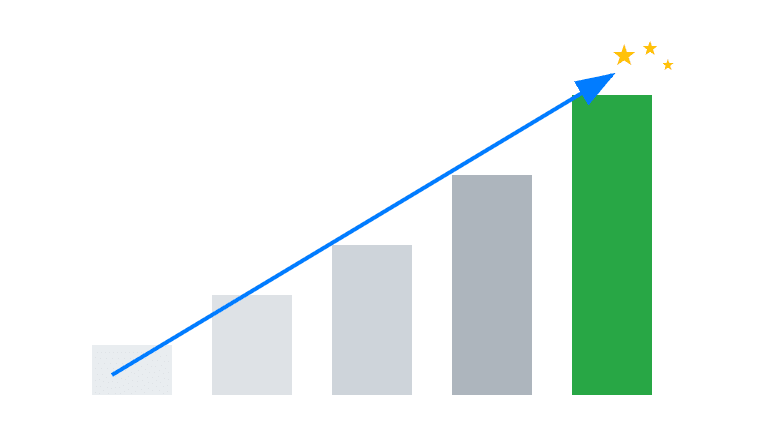
“In the world of Local SEO, your most valuable competitor isn’t your rival; it’s their data. Learn to read it, and you will win.” – A Wise Digital Marketer
Take the First Step Today!
Don’t let another day of potential customers slip through your fingers. Download our free, easy-to-use Competitor GBP Analysis Spreadsheet Template and start building your roadmap to the #1 spot in local search.